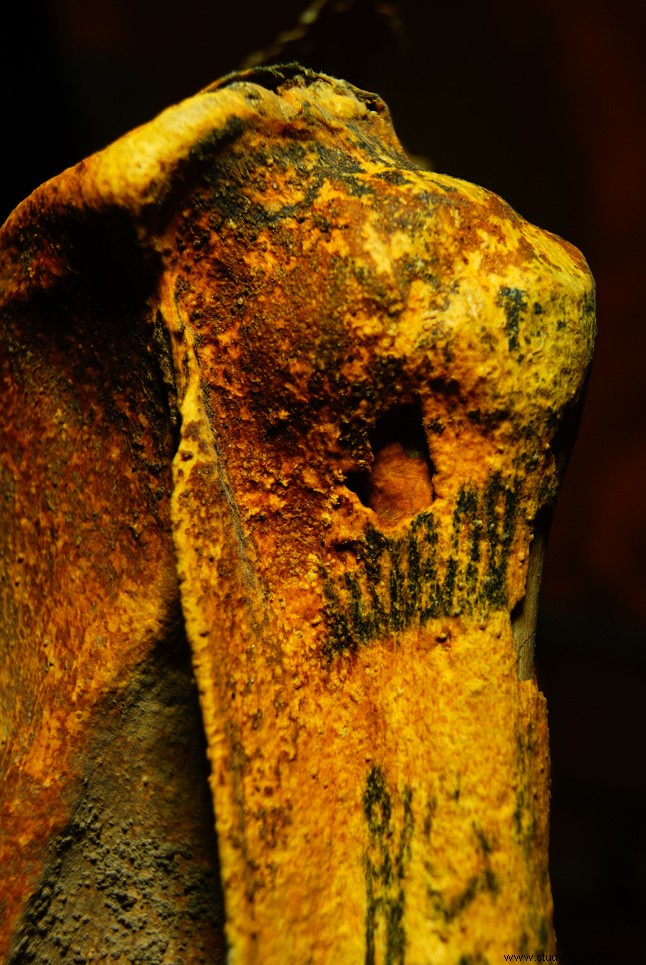In ancient Egypt, the intentional presence of divine images along the arms and neck allowed tattoos to be ritually active during the practice of religious worship.

General view of a 3,300-year-old Egyptian mummy whose neck has been tattooed with two baboons, and three oujdat-eyes.
In 2014, an extraordinary 3,300-year-old mummy, whose body was entirely covered in tattoos, was unearthed at the site of Deir el Medina, on the west bank of Luxor, in Egypt. His study, conducted over 4 years, yielded new results. Announced on October 17, 2018 by the Secretary General of the Supreme Council of Egyptian Antiquities, Mostaf al-Waziri said that this latest expertise confirmed the presence of around thirty figures including a wild bull, a sheep, a lotus flower, a baboon and the eye of Horus (or Oudjat), a powerful protective symbol. Computed tomography and infrared reflectography thus facilitated the identification of all the tattoos present on the skin tissues of the mummy.
Upon the discovery of this high-ranking woman who is believed to have lived between 1300 and 1070 BCE, Sciences et Avenir had conducted an interview with its inventor, Cédric Gobeil, head of the archaeological mission of Deir el-Medina, supported by the French Institute of Oriental Archeology (IFAO). An interview that we invite you to rediscover.
Science and Future:What is this mummy about Is tattooed unique?
Cedric Gobeil: The discovery of a tattooed Egyptian mummy is, in itself, already a major archaeological event. To date, only a dozen of them - all women - are known to Egyptologists. Their tattoos consist of simple geometric lines (lines, dots, etc.). The uniqueness of our find lies in the fact that, for the very first time, there are figured motifs distributed symmetrically on the upper half of the body.

Upper part of the mummy's right arm, decorated with a waving cobra. ©Anne Austin/IFAO Mission
What types of tattoos were you able to identify?
Around 30 tattoos are present on this woman's body, which also makes her the most decorated Egyptian mummy! The motifs, mostly figurative, represent animals (baboons, cows, snakes, etc.), flowers, ritual objects... But there are also hieroglyphs and prophylactic symbols, such as the eyes-oudjat [the eye of the falcon god Horus, a protective attribute (Editor's note)] . This is the very first time that such ornaments have been discovered in the form of a tattoo on a mummified body. Egyptian iconography does contain a few scenes in which we can see women whose bodies are decorated with small motifs – which can also be painted designs – but curiously, we had never yet found these themes on a mummy.
What may have been the role of this woman?
This is one of the fundamental questions related to our discovery and also one of the most difficult, insofar as we can only hypothesize and develop interpretations. Until now, based on previously discovered tattooed mummies and iconographic parallels, Egyptologists have suggested a correlation between the practice of tattooing and worship of the goddess Hathor. This seems to prove our finding. Thus, among the tattoos are, among others, two images of Hathor depicted in her form of a cow with a hathoric crown and a necklace-menat , symbol of fertility, as well as a handle with a Hathor head which could be the support of a mirror. In this context, one can easily imagine that this woman was involved in a worship of the goddess, as a musician, singer or priestess. Otherwise, one can also think of a "magician" acting as an intermediary between the terrestrial world and the divine world. Contemporary texts from the period in which this woman lived attest to the existence of such a practice.
When would this woman have lived?
Thanks to the expertise of our anthropologist Anne Austin, from Stanford University (USA), we were able to establish that the style of mummification corresponds to that practiced during the New Kingdom (1550 and 1070 BC). This clue comes in addition to the fact that the mummy was found in a tomb belonging to a community of craftsmen who worked on the making of the royal tombs dug in the Theban mountains, during this same period.
Will analyzes be extended to other mummies in an attempt to discover similar tattoos?
Yes of course. Our attention is now fixed on this detail and we are hopeful to discover other tattooed mummies in the near future. Tattoos are not always easy to distinguish on mummified skin. The tattoos were discovered by examining computer-processed photos!
Was it common to be tattooed in Pharaonic Egypt?
At first glance, based on the small number of tattooed mummies discovered so far and the iconographic depictions that show individuals with patterns on their bodies, one can assume that this was a rather rare practice. However, just because something hasn't been found doesn't mean it doesn't exist! In other words, our assertion is based on a sample which we do not know if it is representative. There are still a very large number of mummies to unearth and nothing prevents us from thinking that a large number of tattooed individuals may be discovered. Still, it should be kept in mind that not all Egyptians were mummified and that not all mummies have come down to us.
